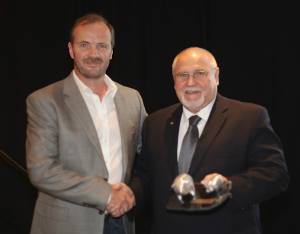Alfred Wahl, who received the 2015 Lifetime Achievement Award at this year’s Pork Congress, has been involved with improving pig breeds in Canada for his entire career. His work in Canada has led to exporting swine genetics around the world, where success can turn suddenly into failure at the drop of a reputation.
Wahl, who operates Polar Genetics Canada and has been in the purebred industry since 1971, had cracked the Chinese market with Canadian breeding stock and started exporting frozen boar semen to them in about 2010, but that door closed when PED hit Canada. Not just to pigs, but even to semen. The importing certificate finally re-opened just this year.
After China, India is home to the next-highest population in the world – seemingly a potentially lucrative market. Wahl was working on getting the semen certificate for India back in 2008, well ahead of the curve before anyone else was sending them pigs, he said.
But India has been an extremely sensitive market.
“Every time they import something there’s an issue with the health of those animals,” he said.
He recalled a livestock event that several years ago hurt the dairy cattle industry. The Indian government had allowed the import of dairy cattle, but found “something they didn’t like” in the health of the cattle, Wahl said.
“You can’t just kill those things in India.”
Because cattle are sacred, they languished for years before dying of natural causes. That kind of event draws a lot of attention to the risks of importing, and government bureaucrats are eager to point the finger at other countries, Wahl said.
Sacred cattle aren’t the only cultural issues that make him shake his head. A country like India is far behind Canada in developing strong swine genetics, and could “leapfrog” a lot of other potential issues by importing good genetics, but government and producers seem determined to rely more on excuses than science.
“I’m not easily suited to telling people how to subsist,” he said, recalling one farmer from the Assam region who insisted his pigs loved the nuts and seeds they found under trees.
“That’s obviously not true,” Wahl said, noting that the farmer probably never gave his pigs any better menu to choose from.
Once while staying at a Hyatt Regency in Ludhiana, India, he saw a sign that the hotel wouldn’t be serving pork because of the swine flu.
“I don’t think there was any swine flu around the Hyatt Regency.”
People in the region were suffering from H1N1, but that, of course, is not transferable through eating pork. Nonetheless, the local pork producer was losing sales.
The world market is risky but still has tremendous potential thanks to Canada’s impressive genetics development programs. Both government and private industry have pushed the development and careful measurement of heritable traits in pigs, so Canada has a broad selection of genetic traits and good records to back up the reputation.
The Best Linear, Unbiased Prediction (BLUP) system developed by the late Brian Kennedy at the University of Guelph set the standard for breeders in Canada to determine what qualities to measure and how to measure them. Now the Canadian Centre for Swine Improvement (CCSI), which took over from the federal Canadian Swine Record of Performance Advisory Board in 1995, has collected data on about 7,000 sows, Wahl explained.
That shared information helps make the performance of Canadian breeds predictable and appealing to developing countries. India has no “pig champion” and hasn’t established a baseline of measurements to help select quality genetics, Wahl said, so they have nothing even comparable.
“China has programs for swine improvement, but they’re not nearly as well organized as what CCSI is.” •
— By Carl Haun





